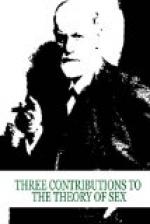[19] The above-mentioned assertions concerning the infantile sexuality were justified in 1905, in the main through the results of psychoanalytic investigations in adults. Direct observation of the child could not at the time be utilized to its full extent and resulted only in individual indications and valuable confirmations. Since then it has become possible through the analysis of some cases of nervous disease in the delicate age of childhood to gain a direct understanding of the infantile psychosexuality (Jahrbuch fuer psychoanalytische und psychopathologische Forschungen, Bd. 1, 2, 1909). I can point with satisfaction to the fact that direct observation has fully confirmed the conclusion drawn from psychoanalysis, and thus furnishes good evidence for the reliability of the latter method of investigation.
Moreover, the “Analysis of a Phobia in a Five-year-old Boy” (Jahrbuch, Bd. 1) has taught us something new for which psychoanalysis had not prepared us, to wit, that sexual symbolism, the representation of the sexual by non-sexual objects and relations—reaches back into the years when the child is first learning to master the language. My attention has also been directed to a deficiency in the above-cited statement which for the sake of clearness described any conceivable separation between the two phases of autoerotism and object love as a temporal separation. From the cited analysis (as well as from the above-mentioned work of Bell) we learn that children from three to five are capable of evincing a very strong object-selection which is accompanied by strong affects.
[20] Some persons can recall that the contact of the moving air in swinging caused them direct sexual pleasure in the genitals.
[21] “Those who love each other tease each other.”
[22] The analyses of neurotic disturbances of walking and of agoraphobia remove all doubt as to the sexual nature of the pleasure of motion. As everybody knows modern cultural education utilizes sports to a great extent in order to turn away the youth from sexual activity; it would be more proper to say that it replaces the sexual pleasure by motion pleasure, and forces the sexual activity back upon one of its autoerotic components.
III
THE TRANSFORMATION OF PUBERTY
With the beginning of puberty the changes set in which transform the infantile sexual life into its definite normal form. Hitherto the sexual impulse has been preponderantly autoerotic; it now finds the sexual object. Thus far it has manifested itself in single impulses and in erogenous zones seeking a certain pleasure as a single sexual aim. A new sexual aim now appears for the production of which all partial impulses cooeperate, while the erogenous zones subordinate themselves to the primacy of the genital zone.[1] As the new sexual aim assigns very different functions to the two sexes their sexual developments now part company. The sexual development of the man is more consistent and easier to understand, while in the woman there even appears a form of regression. The normality of the sexual life is guaranteed only by the exact concurrence of the two streams directed to the sexual object and sexual aim. It is like the piercing of a tunnel from opposite sides.




